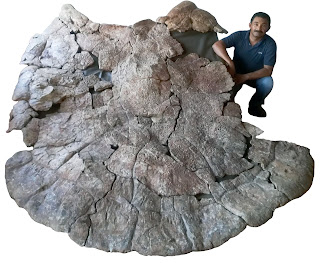To support their bodies, these spineless animals — invertebrates — have skeletons made of protein fibres.
This flexibility can be a real advantage when slipping into nooks and crannies for protection and making a home in seemingly impossible places.
On the east side of Vancouver Island, British Columbia, Canada, there is an area called Madrona Point where beneath the surface of the sea many octopus have done just that. This is the home of the Giant Pacific Octopus, Enteroctopus dofleini, the largest known octopus species.
The land above is the home of the Snuneymuxw First Nation of the Coast Salish who live here, on the Gulf Islands, and along the Fraser River. In Hul'q'umin'um' — the lingua franca of the Snuneymuxw First Nation, a living language that expresses their worldview and way of life — the word for octopus is sqi'mukw'. In the Kwak̓wala language of the Kwakiutl or Kwakwaka'wakw, speakers of Kwak'wala, further north on Vancouver Island, octopus or devil fish are known as ta̱k̕wa.
I have gone scuba diving at Madrona Point many times and visited the octopus who squeeze into the eroded sections of a sandstone ledge about 18 metres or 60 feet below the surface.
On one of those trips, my friend Suzanne Groulx ran into one of the larger males swimming just offshore. I was surfacing as I heard her shriek clear as a bell. Sound moves through water about four times faster than it does through the air — faster than a jet plane.
On that day, I suspect Suzanne was neck and neck both in sound and motion. Seconds later, she popped up a good three feet above the surf, still screaming. I have never seen anyone surface quite so quickly — dangerous and impressive in equal measure. It was on another of those trips that I met Philip Torrens, with whom I would later co-author, In Search of Ancient BC.
While the entire coastline is beautiful to explore, it was visiting the octopus that drew me back time and time again. I have seen wee octopus the size of the palm of your hand, large males swimming and feeding and the lovely females tucked into their nursery homes.
After forty days of mating, the female Giant Pacific Octopus attach strings of small fertilized eggs to the rocks within these crevices and call it home for a time — generally five months or 160 days. When I visit, I sometimes bring crab or sea urchin for her to snack on as the mothers guarding these eggs do not leave to hunt, staying ever vigilante protecting their brood from predators. All the while she is here, she gently blows fresh water over the eggs.
And sadly, this will be her only brood. Octopus breed once in their too-short lives. Males die directly after mating and females die once their young have hatched. They live in all the world's oceans and no matter the species, their lifespans are a brief one to five years. I rather hope they evolve to live longer and one day outcompete the humans who like to snack on them.
Octopus are soft-bodied, eight-limbed molluscs of the order Octopoda. They have one hard part, their beaks, which they use to crack open clams, crab and crustaceans. They are ninja-level skilled at squeezing through very tight holes, particularly if it means accessing a tasty snack. The size of their beaks determines exactly how small a hole they can fit through. Looking, you would likely guess it could not be done, but they are amazing — and mesmerizing!
At the Vancouver Aquarium, they have been known to unscrew lids, sneak out of one tank to feed in another then slip back so you do not notice, open simple hooks and latches — burglars of the sea. They can also change the colour and texture of their skin to blend perfectly into their surroundings. You can look for them around reefs and rocky shores. There are 300 species of octopus grouped within the class Cephalopoda, along with squid, cuttlefish, and nautiloids.
The oldest fossil octopus at 300 million years old is Pohlsepia mazonensis from Carboniferous Mazon Creek fossil beds in Illinois. The only known specimen resembles modern octopuses with the exception of possessing eight arms and two tentacles (Kluessendorf and Doyle 2000).
My favourite fossil octopus is the darling Keuppia levante (Fuchs, Bracchi & Weis, 2009), an extinct genus of octopus that swam our ancient seas back in the Cretaceous.




.jpg)






























